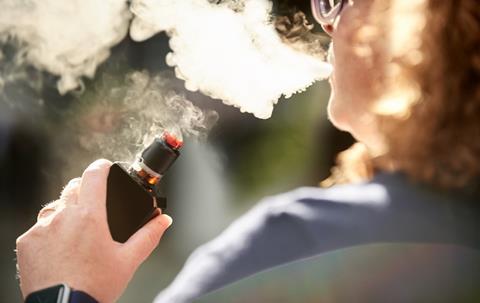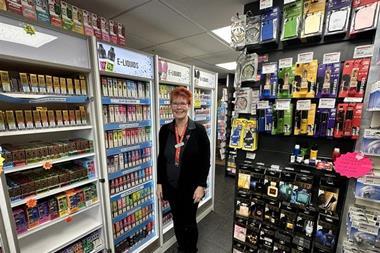
From April 2025 – Parliamentary approval and a change of government notwithstanding – vaping, one of the most lucrative retail categories for forecourts in recent years, will be subject to a barrage of new regulations. It will mean retailers having to completely rethink how they stock and merchandise the category, not unlike when the ban on displaying tobacco products took effect some years back.
The most significant measure for the industry is that disposable vapes – the largest and arguably most profitable part of the e-cigarette market – will be banned as part of a wider clampdown on the underage use of this alternative to cigarettes. As well as outlawing disposable vapes, the rules will restrict flavours seen as appealing to youngsters as well as requiring plain packaging for rechargeable systems.
The irony perhaps of the government’s initiative is that vaping products, including disposables, have been widely seen as successful in helping to wean hardened smokers off a habit that still contributes to tens of thousands of deaths a year. However, ministers worry that, despite vaping’s popularity and effectiveness among adults, many under-18s who have never smoked are attracted to disposable vapes, which still contain addictive levels of nicotine.
Although details have to be spelled out, the government is likely to also change the rules around how vapes are displayed in forecourts and other outlets, ensuring that they are not merchandised alongside the likes of sweets. Ministers will introduce new penalties and trading standards officers given powers to issue on-the-spot fines to retailers found infringing the regulations.
The vaping sector has come under attack from elsewhere in the government too. In his 6 March budget, Chancellor Jeremy Hunt announced that from October 2026, he would impose a levy on vapes for the first time, in addition to 20% VAT. Until now, unlike cigarettes and other tobacco products, vapes have not been subject to a specific tax. Critics warn that making vaping more expensive could deter smokers from quitting.
There is no doubt that a ban on disposable vapes will hurt a forecourt sector for whom e-cigarettes – and disposable vapes in particular – have been one of the bright lights on the retail landscape. The question for the trade – and the vaping industry – is whether alternative vaping products, those already on the market and still to be developed, can fill the gap and deliver similar sales and profits.
According to Nielsen IQ data for the four weeks to 24 February, single-use disposables make up 85% of vaping sales across the whole grocery market. “This is a category that has enabled a significant number of independent convenience stores, including forecourts, to survive post-Covid because disposables offer a profit on return of up to 60%,” says Robert Sidebottom lead of industry lobby group Vape Protection Alliance, and managing director of Arcus Compliance.
One reassurance for retailers is that, until the regulations take effect, it is business as usual for disposable vape products. “It’s unlikely that demand will slow down any time soon, so we recommend that retailers continue to stock a wide range of leading disposables,” says Yawer Rasool, consumer marketing director UK & Ireland at Imperial Brands, which is behind the Blu vaping brand as well as cigarette lines such as Winston and Gauloises.

Aquavape, which makes a range of disposables, liquids, and other vaping products, takes a similar line. “Retailers should maintain good stock levels of their best-selling disposable lines until 1 April next year,” says managing director Ebrahim Kathrada. “A few weeks ahead of the ban, retailers need to ensure they are running down stock levels, but six months before is time to start planning the transition from disposables to their replacements, swapping like-for-like brands and flavours.”
Kathrada encourages retailers to start having “conversations” with their regular customers “to let them know their favourite brand will soon be unavailable”. Store-owners and their staff should also as soon as possible begin to “educate themselves” on which stock is likely to pick up the sales in place of disposables, including the likes of pod and legal “high-puff” devices, suggests the company.

Rasool at Imperial Brands reinforces the importance of informing not just consumers but employees. “One particularly effective way of improving staff knowledge on pod systems is through running product demonstrations using samples,” he says. “Allowing staff to handle the products themselves so they get to know the different components will really help them understand more about how they work and pass this information onto customers.”
According to Anis Safri, sales director at leading vape brand IVG, it is inevitable that retailers will worry about overstocks and whether those who bought disposables will make the switch to compliant products as the ban date draws near. “A drop off in revenue will be a concern, along with the competition that may arise from a strengthening in the sale of illegal disposables,” he says.
So, what are the contenders to replace disposables? Safri says rechargeable and reusable pod devices are the favourites. “Outlets will be relying on the manufacturing and key brands supply chain to have exciting product introductions,” he says. “Retailers will also need supporting educational point of sale material to communicate with former disposable consumers on the benefits of pod device vaping, so there is not a drop off in revenue.”
A recent trend has been big puff devices, such as IVG’s 2400, Aquavape’s Insta Flow 5000, and SKE’s Crystal 4 in 1, which come with four pre-loaded pods and allow users to switch flavours and have a longer vaping experience. Safri says IVG’s 2400 – so named because it offers “2,400 puffs” – has “disrupted” the traditional 600-puff disposable market, and also offers better value to end-users as well as reducing the number of facings retailers require.
According to Marcus Saxton, chairman of the Independent British Vape Trade Association and chief executive of online vaping retailer Totally Wicked, they are attracting “significant consumer interest” and are “poised to challenge the prevalence of illegal big puff devices”. However, disposable versions are likely to be outlawed along with other disposable vapes come next April.

Saxton views pre-filled and refillable pod devices as already “gaining traction as a natural evolution” for disposable vape users, offering familiar flavours and simplicity of use as they “mirror the convenience of disposable vapes”. He advises forecourt operators to focus on “expanding their offerings in these categories to meet the growing demand from consumers seeking viable alternatives to tobacco and disposable vapes”.

Aquavape’s Kathrada recommends that retailers should also offer a broad range of e-liquids to cater to customers “seeking personalised vaping experiences, especially those who may start venturing from pod or legal big puff systems to vape mods and open system devices”. Former customers of disposable products will “still opt for devices that are easy to use, portable and discreet, an experience similar to disposables”, he says.
Sidebottom of the Vape Protection Alliance expects one non-vaping area of the market that could also do well from the vaping ban is nicotine pouches, as they will not be subject to excise duty. Kathrada concurs: “With increasing scrutiny on traditional vaping products, we can see a shift towards nicotine pouches,” he says. “These offer a smoke-free and often odourless way to consume nicotine, which may appeal to individuals looking to quit smoking.”
One of the biggest challenges for the vaping sector – and one which some suspect could be given a boost by the outlawing of disposables – is the illegal market. “Illegal disposable vape products exist in the market today and have the risk of further growth in the event of a ban,” says Sexton. “It’s imperative that the authorities aggressively combat the illegal importation and distribution of such products.”
The Association of Convenience Stores (ACS) says by targeting responsible retailers, the government has its priorities wrong. “It is rogue sellers that are supplying dodgy products to anyone who wants them, including children, and operating without fear of reproach from trading standards teams,” says ACS. “What we need is a coherent strategy focused on enforcing the rules we have and providing enforcement teams with resources to do their jobs properly.”
Sidebottom worries that some of the government’s measures – such as banning many flavours of vapes – could deter smokers from giving up. “Flavours are very important to ex-smokers as they want to move as far away as possible from associations with tobacco. If the government does restrict flavours they will be increasing the likelihood of public health harm,” he says.
One of the biggest problems with the government’s measures for the vaping market, argues Sidebottom, is the uncertainty around timing and some of the details. “It’s unfair to businesses because they are not providing a clear timeline,” he says. “Retailers need to know what the rules will be well in advance to they can make plans and adjust their business models.”
IVG’s Safri agrees. If the government comes up with a “phased and sensible transitioning timeline”, the move away from disposables should be manageable, he says. “Without this there could be overstocks and huge discounting of disposables which will potentially exacerbate the underage disposable vaping issue.”
Of course, one of the biggest question marks hanging over the entire vaping crackdown is whether this government be around long enough to enact the legislation, and, if not, will an incoming Labour administration continue where the Conservatives left off? Although “nothing is certain in politics”, Sidebottom believes a Sir Keir Starmer-led government will take a similar stance on vaping to the current one. After all, the devolved administrations have all gone ahead with similar initiatives.
Downloads
2400 devices - Copy
Image, Size 11.97 mb
































